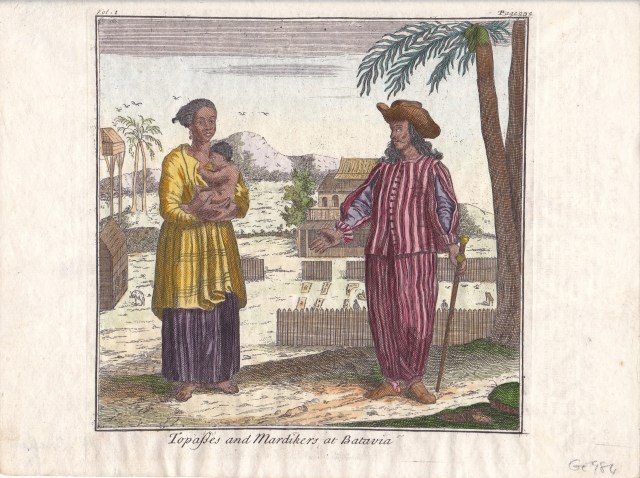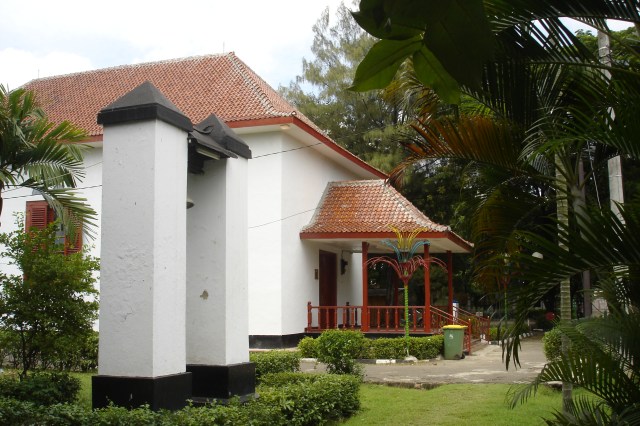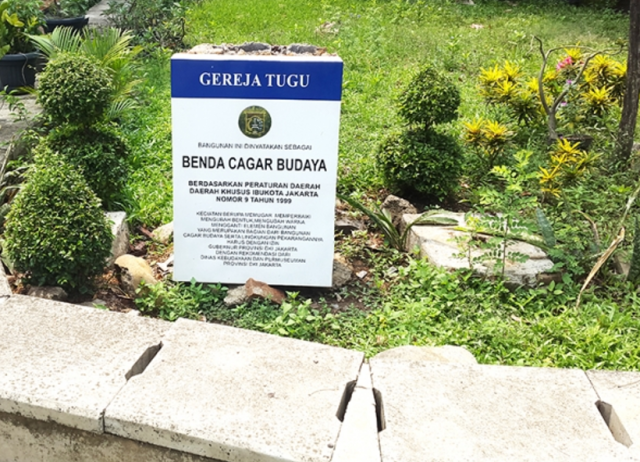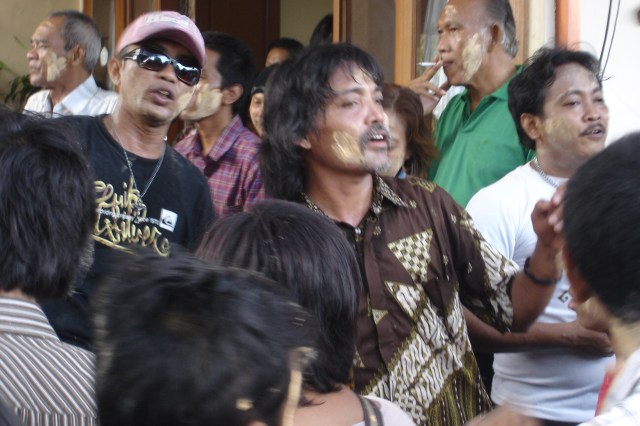In 1699 the population of Batavia consisted of 3679 Chinese, 2407 Mardjikers or Portuguese Eurasians, 1,783 Dutch, 670 Dutch Eurasians and the original inhabitants or Orang Betawi.
These Portuguese Eurasians had been brought to Batavia as slaves or indentured labour after the Dutch East India Company (VOC) captured Malacca and Galle from the Portuguese in 1640. They became a vital part of the VOC workforce as labourers, artisans, clerks and soldiers.
However, the presence of Christian slaves in Batavia became an ethical dilemma for the Dutch Reform Church and in 1661 they were freed and granted land outside Batavia on the condition that they convert from Catholicism and they became known as the Mardijkers or Freedmen.

A Mardijker couple, presumably on the land granted to them outside Batavia in 1661, with possibly their original church in the background
The Mardijkers were granted land at Kampong Tugu (Toegoe) which is now near the port area of Tanjung Priok. At that time 150 Mardijkers moved to this area and after three centuries there is still a community living there. They have retained their original identity over this time and their land contains their own church, graveyard, schools, community centre and cultural centre.
A search of the cemetery shows the family names of Michiels, Qiuko, Thomas, Corua and Abrahams are prominent. The most successful of the Mardijkers was Augustin Michiels who became commander of the indigenous militia and a wealthy landlord.
After 350 years the Mardijkers of Kampung Tugu are still proud of their identity and the photo shows one of the Michiels family wearing a T-shirt showing the Portuguese shield and the breaking of the chains of slavery in 1661.

A modern day Mardijker from Kampung Tugu
The original wooden church built in Kampong Tugu after 1661, burnt down and was rebuilt in stone, this was renovated in 2007 and is now designated as an historic landmark by the city of Jakarta.

The bell tower and entrance to the historic Tugu church

Gereja Tugu. A designated historic landmark by the City of Jakarta
The Mardijkers have kept their musical tradition alive until today through the small ukulele style instrument known as the keroncong. It is this instrument that has given its name to their music which is derived from old Portuguese folk songs influenced by the music of North Africa and known as Portuguese Mouresco. Originally played by street musicians the music gained wider acceptance during the Dutch colonial period when it was played together with a violin, guitar, bass, tambourine and flute. It evolved to include Dutch and Indonesian songs and the Krontjong Toegoe band has performed in Holland where the song ‘Oud Batavia’ brings tears of nostalgia to a generation of Hollanders who still remember the old times or the ‘tempo doeloe’ in Indonesia.

The Krontjong Toegoe band preparing to play ‘Oud Batavia’
The Mardijkers celebrate the New Year with great gusto in an event called Mande-Mande, whose origins probably belong in India or Sri Lanka, which includes the custom of smearing each others faces with a mixture of water and face powder.

Here Andre Michiels celebrates Mande-Mande with other members of the Mardijker community in Kampung Tugu

This is a fascinating community. I live in Jakarta and can’t believe I haven’t heard of them. I’ll have to arrange an outing to North Jakarta soon to see it in person.
Hi Randy, I am back in Jakarta now lets organise a day to visit Kampung Tugu. A Sunday for the church service would be best.
Dear Ian,
Season’s greetings.
I’m writing from the National Library Board, Singapore. My name is Veronica Chee and I am the editor of BiblioAsia, the National Library Board‘s quarterly magazine on the history, culture and heritage of Singapore. We publish the print and online versions of the magazine (https://biblioasia.nlb.gov.sg).
We are running an article about the Portuguese influence in Southeast Asia in the upcoming Apr-Jun 2023 issue of the magazine and would like to use the coloured image of the Mardijker couple in our magazine, for both the print and online versions.
I found the black-and-white version on the website of the British Museum (https://www.britishmuseum.org/collection/image/1613498013). But the coloured image looks more interesting and we would prefer to use that instead. May I know the source of the coloured version?
Thank you
Regards
Veronica
Ms Veronica CHEE
Senior Editor | Publishing
National Library
National Library Board